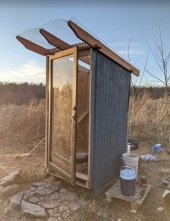posted 11 years ago
Here is a thread devoted to my yard project: turning a standard suburban yard of about a quarter acre into a permaculture paradise. This will be intensive rather than extensive permaculture: the goal is to feed eight people all of their fruits and vegetables, as well as some protein, while creating a thriving ecosystem to replace the spotty lawn and dying bushes. The site is in the Denver Metro, in the Platte river valley, in climate zone five. Summers are dry and fairly hot, while winters are mild and sunny for the most part, with occasional cold fronts and blizzards which quickly pass, but do lots of damage to unprepared plants which were basking in the warmth the day before. Spring and Fall are poorly defined; an eighty degree day in October can be followed by a blizzard the next day, bringing down trees with the weight of snow on the leaves. The high altitude means that the sun is quite intense, and there is a huge temperature difference between day and night, due to radiational cooling. The neighborhood is moderately good habitat, with large old trees, a few creeks/ trails, brushy areas around a small lake, and other good habitat areas.
I have not yet got a master plan done. Every time I think I am getting it, I read something else and get new ideas. So I have decided to go ahead and build the elements I am certain of, and work other things in around them over time.
My first project will be a combination of raised wicking beds, french drains, and an arbor on the southwest side of the house.
There are a couple of goals with this project: using the warm microclimate of a southwest facing wall; keeping water away from the foundation and basement window wells; shading the wall and windows in the summer; generating salads year around; and adding some interest to the yard.
Here is a series of sketchup models and pictures of the project.

 1
1




 1
1




![Filename: pipe-overview-copy.jpg
Description: [Thumbnail for pipe-overview-copy.jpg]](/t/39202/a/20660/pipe-overview-copy.jpg)
 1
1




![Filename: Small-pipes-close-up.jpg
Description: [Thumbnail for Small-pipes-close-up.jpg]](/t/39202/a/20661/Small-pipes-close-up.jpg)
 1
1




![Filename: rubble.jpg
Description: [Thumbnail for rubble.jpg]](/t/39202/a/20662/rubble.jpg)
 1
1




![Filename: walls.jpg
Description: [Thumbnail for walls.jpg]](/t/39202/a/20663/walls.jpg)
 1
1




![Filename: pond-liner.jpg
Description: [Thumbnail for pond-liner.jpg]](/t/39202/a/20664/pond-liner.jpg)
 1
1




![Filename: gravel.jpg
Description: [Thumbnail for gravel.jpg]](/t/39202/a/20665/gravel.jpg)
 1
1




![Filename: soil.jpg
Description: [Thumbnail for soil.jpg]](/t/39202/a/20666/soil.jpg)
 1
1




![Filename: final.jpg
Description: [Thumbnail for final.jpg]](/t/39202/a/20667/final.jpg)
 1
1




 1
1




 1
1




 2
2




 1
1




 1
1




 2
2




 1
1




 1
1




 2
2








![Filename: IMG_4046.jpg
Description: [Thumbnail for IMG_4046.jpg]](/t/39202/a/22010/IMG_4046.jpg)
 1
1




 1
1




 1
1









